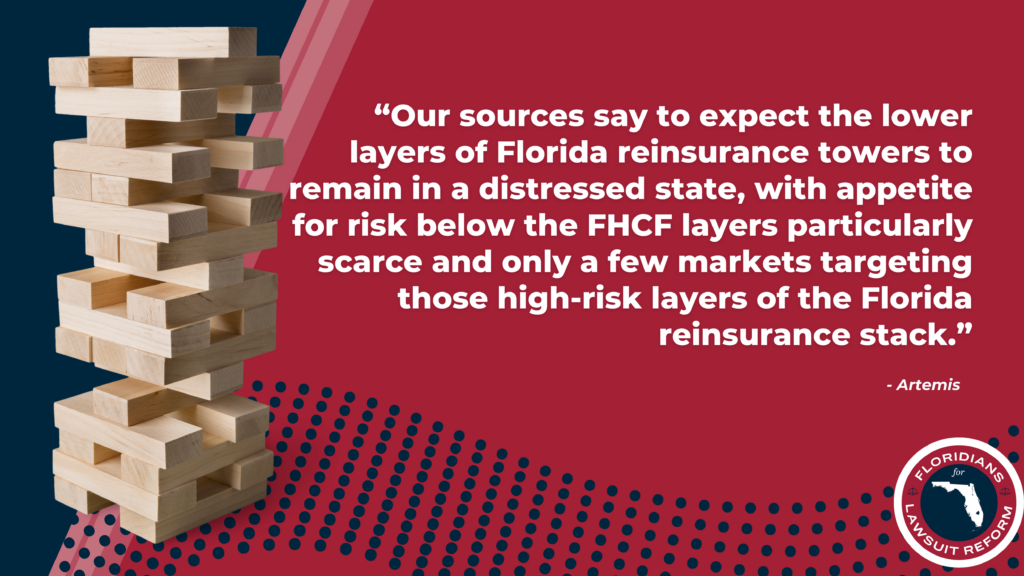
At this time of year, all thoughts turn to the mid-year reinsurance renewals, particularly those for Florida, and in 2023 it’s expected to be a particularly interesting few months, with signs of competitive tactics already emerging.
With the hard reinsurance market still in effect and additional rate firming anticipated for towers focused on and exposed to the Sunshine State, we’re already being told of strategies being employed to help markets secure access to the risk they want.
Our sources say to expect the lower layers of Florida reinsurance towers to remain in a distressed state, with appetite for risk below the FHCF layers particularly scarce and only a few markets targeting those high-risk layers of the Florida reinsurance stack.
As you move up the tower, additional year-on-year rate increases are broadly anticipated right to the top, driving higher reinsurance costs again for the Florida specialists and those with significant property catastrophe exposure there.
But, how significant the incremental firming or hardening of rates for Florida reinsurance towers will be, at the mid-to higher layers, remains to be seen, with some competitive dynamics in play that are set to influence just how firm things get.
One of the most interesting dynamics we’re hearing about, at this still early stage of the 2023 Florida catastrophe reinsurance renewal, is for some markets to adopt a strategy to secure their participation in the lower, higher-returning layers of Florida towers, by offering discounts for participation in the higher layers of programs.
Effectively this translates to discounts being offered for reinsurance participation at the upper-layers of towers, alongside increases in shares being requested for some of the mid-layers, but only if signed shares are allocated to the market across the tower (at least all the layers it wants access to).
By helping Florida cedents fill out their top layers of reinsurance towers more cost-effectively, while getting guaranteed participation, sometimes with enlarged shares around the layers just above the FHCF, these markets are aiming to get secured access to the layers with the higher returns as well, so a sound strategy and with benefits for both sides.
But, of course, one market’s strategy will have ramifications for the rest of the renewals, especially as for many reinsurers those upper-layers are now the only destination in the tower they really want to deploy capacity into.
Which could drive increased competition at those mid to upper-layers of reinsurance towers, it seems, potentially acting as a moderating influence on rate firming if this becomes a trend we see across the marketplace.
It’s also worth considering that these upper-layers of Florida reinsurance towers, or even of US nationwide catastrophe reinsurance towers, are also the layers where catastrophe bonds tend to sit.
With catastrophe bond rates and pricing beginning to come off the highs seen back in the first-quarter and the majority of new cat bonds increasing in size, while pricing down, the competitive pressure in upper-layers of reinsurance towers is already perhaps evident.
Our industry-loss warranty (ILW) pricing data also shows a slight softening, or moderation of firmer expectations, off the record-high rates-on-line recently seen.
It means that, in the upper-layers, where the majority of reinsurance markets are most comfortable deploying their capacity right now, once we get to firm-order-terms, these could be influenced by markets that are generating their rate from participation at the lower-layers, allowing them to discount more up the top.
That, alongside cat bond price moderation, could come together to reduce the upward-pressure on top-layer rates-on-line, it seems.
While it’s still distressed at the bottom of catastrophe reinsurance towers and firm-to-hard most of the way up, the more competition and price-related pressure seen at the top, the more capacity we can expect to look for a home further down as well, with implications for the mid-tier layers, it would seem sensible to assume.
Naturally, there are markets likely to offer better priced coverage lower-down in order to secure more access to higher layers as well, so this dynamic will likely be seen in both directions as the renewal negotiations proceed.
Of course, we’re still a long way out from the mid-year reinsurance renewal signings, for June 1st with its Florida focus, or July 1st with its broader US nationwide focus as well.
So conditions could still change and discipline could hold stronger, driving a harder renewal for cedents.
But, it’s important to consider dynamics in the market that could reduce the level of hardening seen, while driving higher competition.
We all know how competition goes in this market. Particularly so, if you watched reinsurance renewal dynamics evolve through the 2010’s, when inflows of new capital were driving a highly-competitive response from major traditional reinsurers, escalating the softening trend and driving significant term relaxation as well.
Competitive dynamics are already very evident for the mid-year 2023 reinsurance renewals and to be expected, after all these kinds of strategies are seen every year.
If we see more new capital enter (no matter the form), that could drive a stronger response. Perhaps enticing more reinsurers towards the mid-and lower layers of reinsurance towers, with an inevitable effect on the level of rate firming or hardening that will be seen.
We’re still likely looking at year-on-year rate firming across the entire Florida market reinsurance tower, but there are open questions as to how much firming will be seen and which layers will firm the most.
